4、上海复旦大学管理学院EDP介绍合集
- 格式:ppt
- 大小:457.00 KB
- 文档页数:13
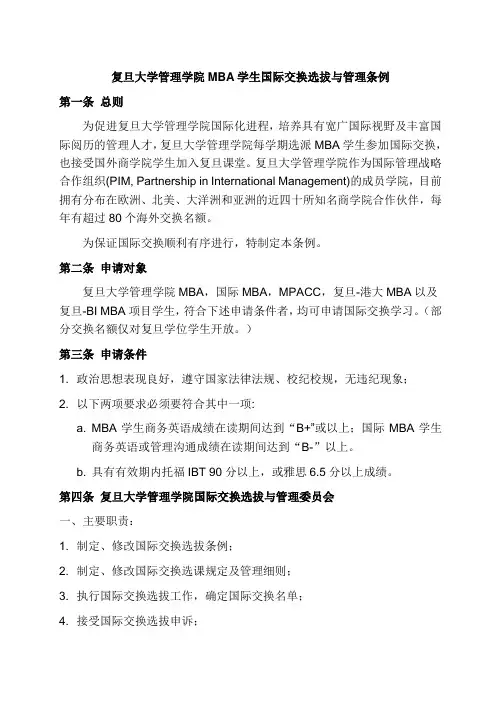
复旦大学管理学院MBA学生国际交换选拔与管理条例第一条总则为促进复旦大学管理学院国际化进程,培养具有宽广国际视野及丰富国际阅历的管理人才,复旦大学管理学院每学期选派MBA学生参加国际交换,也接受国外商学院学生加入复旦课堂。
复旦大学管理学院作为国际管理战略合作组织(PIM, Partnership in International Management)的成员学院,目前拥有分布在欧洲、北美、大洋洲和亚洲的近四十所知名商学院合作伙伴,每年有超过80个海外交换名额。
为保证国际交换顺利有序进行,特制定本条例。
第二条申请对象复旦大学管理学院MBA,国际MBA,MPACC,复旦-港大MBA以及复旦-BI MBA项目学生,符合下述申请条件者,均可申请国际交换学习。
(部分交换名额仅对复旦学位学生开放。
)第三条申请条件1. 政治思想表现良好,遵守国家法律法规、校纪校规,无违纪现象;2. 以下两项要求必须要符合其中一项:a. MBA学生商务英语成绩在读期间达到“B+”或以上;国际MBA学生商务英语或管理沟通成绩在读期间达到“B-”以上。
b. 具有有效期内托福IBT 90分以上,或雅思6.5分以上成绩。
第四条复旦大学管理学院国际交换选拔与管理委员会一、主要职责:1. 制定、修改国际交换选拔条例;2. 制定、修改国际交换选课规定及管理细则;3. 执行国际交换选拔工作,确定国际交换名单;4. 接受国际交换选拔申诉;5. 讨论和决定有关国际交换的其他重要事项。
二、人员组成:主席:管理学院殷志文副院长委员:复旦MBA项目主任祁新娥、国际MBA项目主任孙龙、MPACC项目主任娄贺统、复旦-港大MBA项目主任谢昊、复旦-BI MBA项目主任徐惠忠、管理学院国际交流与交换办公室(IEC: International Exchange and Cooperation Office)主任许丽华。
三、执行机构:管理学院国际交流与交换办公室是国际交换选拔与管理的执行机构,它负责国际交换的各项事务工作,包括发布国际交换通知,接受国际交换申请,组织国际交换选拔,公布国际交换名单等。
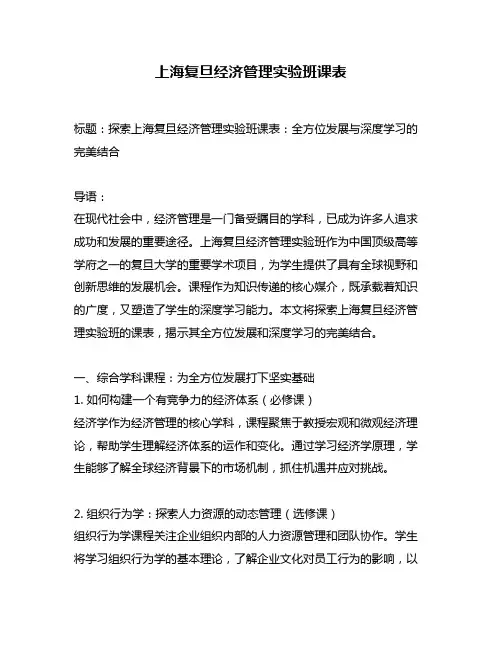
上海复旦经济管理实验班课表标题:探索上海复旦经济管理实验班课表:全方位发展与深度学习的完美结合导语:在现代社会中,经济管理是一门备受瞩目的学科,已成为许多人追求成功和发展的重要途径。
上海复旦经济管理实验班作为中国顶级高等学府之一的复旦大学的重要学术项目,为学生提供了具有全球视野和创新思维的发展机会。
课程作为知识传递的核心媒介,既承载着知识的广度,又塑造了学生的深度学习能力。
本文将探索上海复旦经济管理实验班的课表,揭示其全方位发展和深度学习的完美结合。
一、综合学科课程:为全方位发展打下坚实基础1. 如何构建一个有竞争力的经济体系(必修课)经济学作为经济管理的核心学科,课程聚焦于教授宏观和微观经济理论,帮助学生理解经济体系的运作和变化。
通过学习经济学原理,学生能够了解全球经济背景下的市场机制,抓住机遇并应对挑战。
2. 组织行为学:探索人力资源的动态管理(选修课)组织行为学课程关注企业组织内部的人力资源管理和团队协作。
学生将学习组织行为学的基本理论,了解企业文化对员工行为的影响,以及如何激发员工的潜力。
这门课程培养了学生的沟通、领导和决策能力,为未来担任管理岗位打下基础。
3. 金融市场与投资(选修课)金融市场与投资课程探讨了金融业的基本原理和工具。
学生将学习金融市场的运作方式、金融产品的种类以及投资策略的选择。
学生还将了解投资风险和回报的关系,以及如何进行有效的资产配置。
这门课程将帮助学生发展独特的投资眼光和理财技能。
二、领导力与创新课程:推动深度学习的关键驱动力1. 领导与决策(必修课)领导与决策课程重点培养学生的领导才能和决策能力。
通过学习领导案例、参加团队项目和模拟游戏等活动,学生将锻炼自己的沟通、合作和问题解决能力。
在这门课程中,学生将深入了解领导力的不同理论和实践,发展有效的领导技能。
2. 创业与创新管理(选修课)创业与创新管理课程为学生成为创业家提供了必要的知识和技能。
学生将学习创业过程中的关键问题,了解如何进行市场研究、商业计划的编写以及资金筹集。
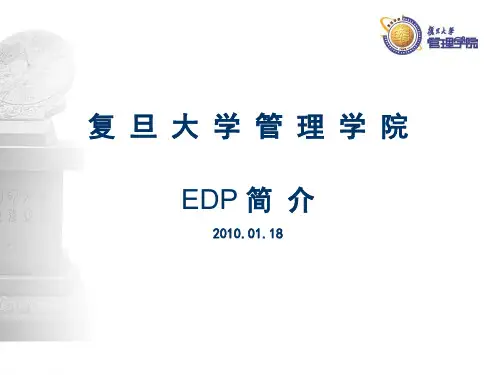

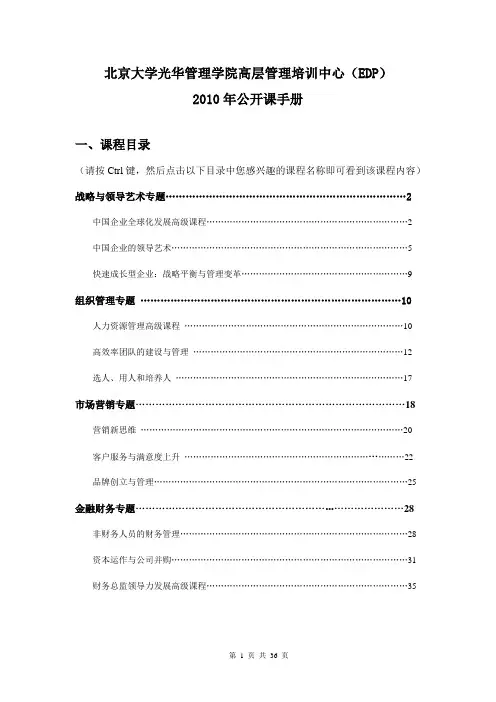
北京大学光华管理学院高层管理培训中心(EDP)2010年公开课手册一、课程目录(请按Ctrl键,然后点击以下目录中您感兴趣的课程名称即可看到该课程内容)战略与领导艺术专题 (2)中国企业全球化发展高级课程 (2)中国企业的领导艺术 (5)快速成长型企业:战略平衡与管理变革 (9)组织管理专题 (10)人力资源管理高级课程 (10)高效率团队的建设与管理 (12)选人、用人和培养人 (17)市场营销专题 (18)营销新思维 (20)客户服务与满意度上升 (22)品牌创立与管理 (25)金融财务专题 (28)非财务人员的财务管理 (28)资本运作与公司并购 (31)财务总监领导力发展高级课程 (35)二、课程简介(一)课程类别:战略与领导艺术专题课程名称:中国企业全球化发展高级课程主讲:武常岐等培训时间及天数:12月09日-12日,共4天培训地点:北京课程前言(背景):当前,我国企业“走出去”已进入较快发展时期,对跨国经营管理人才质量和数量提出了更高的要求。
为配合商务部“人才强商”战略及国家“走出去”战略的稳步实施,使我国“走出去”企业熟悉和掌握主要国别市场的经济、文化、法律法规等特点,规避跨国经营中的各种风险,特开设跨国经营管理人才培训课程。
跨国经营管理人才培训的课程设计突出针对性和实效性,培训内容紧密围绕跨国企业在日常经营管理活动中遇到的实际问题展开,专题明确、特色鲜明,对实际工作具有很好的指导意义。
课程收益:>> 引导企业家树立全球化发展的战略眼光>> 了解我国企业对外投资合作的政策措施>> 了解我国的外交政策,以及外交为企业“走出去”提供的各种服务>> 提供与重点国家高端人士直接对话的机会,了解重点国家的投资环境和政策>> 与企业高管人员深入探讨中国企业海外发展之路适合对象:中央企业及其二级公司、地方大型国有企业和重点民营企业的高层管理者、跨国业务的相关负责人。

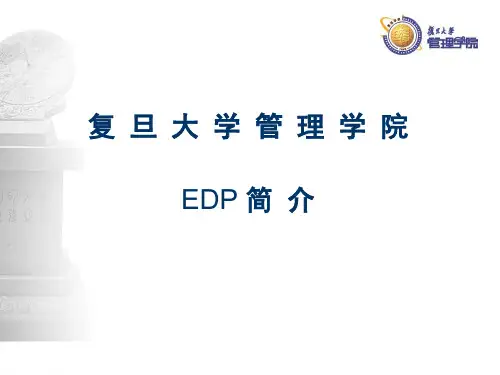
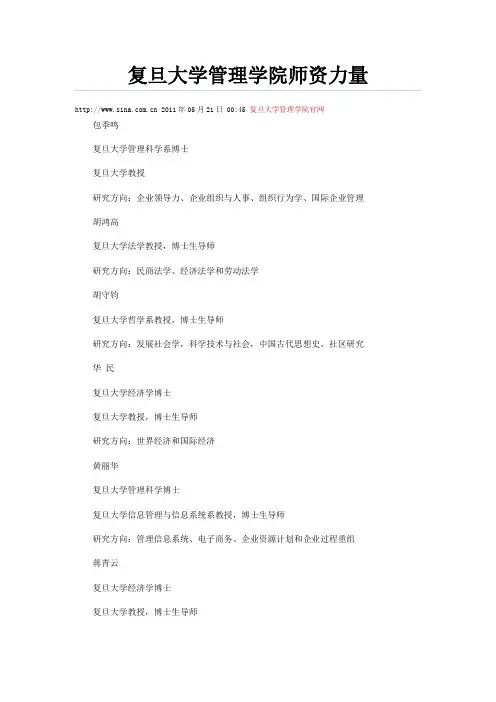
复旦大学管理学院师资力量 2011年05月21日 00:45 复旦大学管理学院官网包季鸣复旦大学管理科学系博士复旦大学教授研究方向:企业领导力、企业组织与人事、组织行为学、国际企业管理胡鸿高复旦大学法学教授,博士生导师研究方向:民商法学、经济法学和劳动法学胡守钧复旦大学哲学系教授,博士生导师研究方向:发展社会学,科学技术与社会,中国古代思想史,社区研究华民复旦大学经济学博士复旦大学教授,博士生导师研究方向:世界经济和国际经济黄丽华复旦大学管理科学博士复旦大学信息管理与信息系统系教授,博士生导师研究方向:管理信息系统、电子商务、企业资源计划和企业过程重组蒋青云复旦大学经济学博士复旦大学教授,博士生导师研究方向:市场营销理论、营销渠道管理、网络营销和企业战略孔爱国复旦大学经济学博士复旦大学教授、博士生导师研究方向:公司金融、金融经济、资本市场理论和实证金融李若山厦门大学审计学博士我国第一位审计学博士复旦大学会计学系教授,博士生导师研究方向:会计理论、审计理论和内部控制刘杰同济大学管理科学与工程博士复旦大学教授、博士生导师研究方向:管理信息系统、电子商务与电子政务陆雄文美国达特茅斯大学塔克商学院博士后,复旦大学经济学博士复旦大学市场营销系教授、博士生导师研究方向:中国不成熟市场营销、因特网营销、服务营销和组织变革卢晓法国高等经济与商业学院博士复旦大学市场营销系讲师研究方向:亚洲奢侈品消费者和奢侈品品牌管理吕长江吉林大学数量经济学博士复旦大学会计学系教授,博士生导师研究方向:会计与资本市场、管理会计芮明杰复旦大学工业经济博士复旦大学教授,博士生导师研究方向:产业与企业发展、企业战略与经营、现代公司理论、知识管理与创新苏勇复旦大学工业经济博士复旦大学企业管理系教授,博士生导师研究方向:企业战略与文化组织行为与人力资源品牌战略与消费者行为孙一民复旦大学工业经济博士复旦大学市场营销系副教授研究方向:品牌管理,时尚与奢侈品营销项保华浙江大学管理工程博士复旦大学教授,博士生导师研究方向:企业战略、管理决策徐惠忠挪威管理学院管理学硕士复旦大学市场营销系副教授研究方向:管理沟通、商务英语郁义鸿复旦大学工业经济博士复旦大学教授,博士生导师研究方向:产业组织理论、产业竞争与企业战略张延玲英国赫尔大学管理系统硕士复旦大学市场营销系讲师研究方向:管理沟通,商务英语,谈判学赵伟韬复旦大学英语语言文学博士复旦大学市场营销系讲师研究方向:跨文化管理,管理沟通郑祖康美国哥伦比亚统计学博士复旦大学统计学系教授,博士生导师研究方向:专长数理统计,主要研究方向为生存分析、序贯分析、非参数分析等郑明复旦大学博士复旦大学教授研究方向:生存分析、经济统计中的计量方法、抽样调查等。
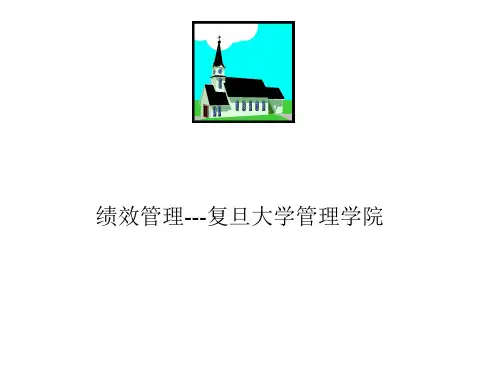
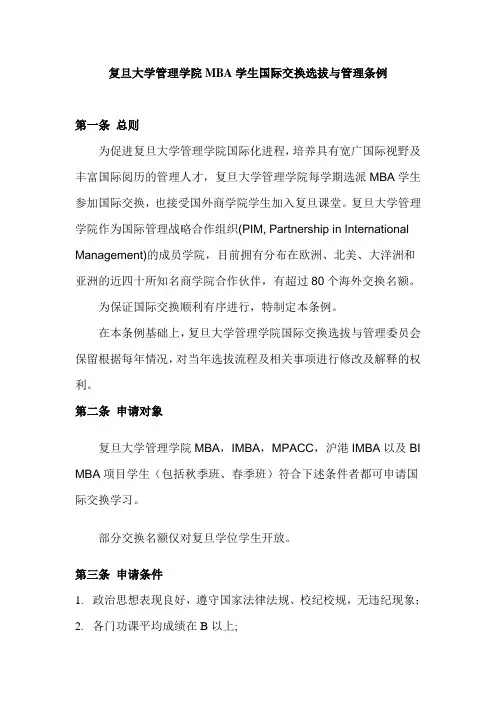
复旦大学管理学院MBA学生国际交换选拔与管理条例第一条总则为促进复旦大学管理学院国际化进程,培养具有宽广国际视野及丰富国际阅历的管理人才,复旦大学管理学院每学期选派MBA学生参加国际交换,也接受国外商学院学生加入复旦课堂。
复旦大学管理学院作为国际管理战略合作组织(PIM, Partnership in International Management)的成员学院,目前拥有分布在欧洲、北美、大洋洲和亚洲的近四十所知名商学院合作伙伴,有超过80个海外交换名额。
为保证国际交换顺利有序进行,特制定本条例。
在本条例基础上,复旦大学管理学院国际交换选拔与管理委员会保留根据每年情况,对当年选拔流程及相关事项进行修改及解释的权利。
第二条申请对象复旦大学管理学院MBA,IMBA,MPACC,沪港IMBA以及BI MBA项目学生(包括秋季班、春季班)符合下述条件者都可申请国际交换学习。
部分交换名额仅对复旦学位学生开放。
第三条申请条件1.政治思想表现良好,遵守国家法律法规、校纪校规,无违纪现象;2.各门功课平均成绩在B以上;3.以下两项要求必须要符合其中一项:a.MBA学生商务英语成绩在读期间达到“A”;国际MBA学生商务英语在读期间达到“B”以上。
b.具有有效期内托福580分以上,或雅思6分以上成绩。
第四条复旦大学管理学院国际交换选拔与管理委员会一、主要职责:1.制定、修改国际交换选拔条例;2.制定、修改国际交换选课规定及管理细则;3.执行国际交换选拔工作,确定国际交换名单;4.接受国际交换选拔申诉;5.讨论和决定有关国际交换的其他重要事项。
二、人员组成:主任:管理学院副院长:殷志文成员:MBA及国际MBA项目主任,沪港MBA项目主任,BI MBA 项目主任。
三、执行机构:复旦大学国际MBA项目是MBA国际交换选拔的执行机构,它负责国际交换选拔的各项事务工作,包括发布国际交换通知,接受国际交换申请,组织国际交换复试,公布国际交换名单等。

招生院系:管理学院 院系说明:本院除工商管理硕士外,拟招收60—70%左右推免生;应用经济学、管理科学与工程、工商管理下设各专业按一级学科统一招生,实行硕博连读;概率论与数理统计、运筹学与控制论专业实行硕博连读。
招生院系:管理学院 院系说明:本院除工商管理硕士外,拟招收60—70%左右推免生;应用经济学、管理科学与工程、工商管理下设各专业按一级学科统一招生,实行硕博连读;概率论与数理统计、运筹学与控制论专业实行硕博连读。
招生院系:管理学院 院系说明:本院除工商管理硕士外,拟招收60—70%左右推免生;应用经济学、管理科学与工程、工商管理下设各专业按一级学科统一招生,实行硕博连读;概率论与数理统计、运筹学与控制论专业实行硕博连读。
招生院系:管理学院 院系说明:本院除工商管理硕士外,拟招收60—70%左右推免生;应用经济学、管理科学与工程、工商管理下设各专业按一级学科统一招生,实行硕博连读;概率论与数理统计、运筹学与控制论专业实行硕博连读。
招生院系:管理学院 院系说明:本院除工商管理硕士外,拟招收60—70%左右推免生;应用经济学、管理科学与工程、工商管理下设各专业按一级学科统一招生,实行硕博连读;概率论与数理统计、运筹学与控制论专业实行硕博连读。
招生院系:管理学院 院系说明:本院除工商管理硕士外,拟招收60—70%左右推免生;应用经济学、管理科学与工程、工商管理下设各专业按一级学科统一招生,实行硕博连读;概率论与数理统计、运筹学与控制论专业实行硕博连读。
招生院系:管理学院 院系说明:本院除工商管理硕士外,拟招收60—70%左右推免生;应用经济学、管理科学与工程、工商管理下设各专业按一级学科统一招生,实行硕博连读;概率论与数理统计、运筹学与控制论专业实行硕博连读。
招生院系:管理学院 院系说明:本院除工商管理硕士外,拟招收60—70%左右推免生;应用经济学、管理科学与工程、工商管理下设各专业按一级学科统一招生,实行硕博连读;概率论与数理统计、运筹学与控制论专业实行硕博连读。
复旦大学MBA 项目简介
自1991 年开展MBA 教育以来,复旦大学管理学院立足中国国情,借助上海得天独厚的经济优势,充分撷取国外先进工商管理教育经验的精华,逐步走向了将国内外优秀工商管理教育经验荟萃于复旦的创新之路,取得了令人瞩目的出色成绩,使得复旦MBA 品牌深入人心、广受赞誉。
2001 年,复旦大学MBA 项目获得教育部唯一国家级优秀教学成果一等奖。
一流的生源和层层选拔的评估机制是打造国际著名MBA 品牌的保障。
复旦大学MBA 项目每年吸引了众多优秀的海内外莘莘学子前来报考。
在拥有中国最具发展潜质学生的同时,复旦大学MBA 项目的国际学生比例也在大幅攀升,国际化程度持续显著提升。
复旦大学MBA 项目计划招收500 名学生(不包含企业合作项目学生)。
任课教师均为管理学院和其他院系有丰富理论知识和实践经验的教授担任。
我校MBA 开设国际经营、市场营销、财务管理、信息管理与电子商务、物流管理、创业与创业投资、金融机构管理、会计、体育产业、医院管理等众多专业选修课程。
学生修满规定学分,完成硕士论文并通过答辩,可获得复旦大学硕士研究生毕业证书和工商管理硕士学位证书。
一、报考条件:
1、算至入学时,本科毕业后有三年及三年以上工作经验者;大专毕业后有五年及五年以上工作经验者;已获硕士学位或博士学位并有二年及二年以上工作经验者。
2、参加由复旦大学MBA 项目组织的预审,并申请复旦大学MBA 项目。
二、学制:。
Consumer Theory III:Duality1The Dual Problem1.1Expenditure Minimization1.The expenditure minimization problem:p:xminxs:t:u(x) u;x 0:The solution to this problem tells us the minimum expenditure that is necessary such that the consumer’s utility is not lower than u.2.Solving this problem tells the decision-maker(e.g.the government)the payment necessary to keep a person’s utility above a minimum level.3.De…nitions:A solution to the expenditure minimization problemis known as the Hicksian demand function and is denoted byx h(p;u):Substituting x h(p;u)into the objective function gives us the ex-penditure functione(p;u) p x h(p;u):4.Properties of Hicksian Demand:Suppose u is continuous and strictlyincreasing,then x h has the following properties:(a)Homogeneity of degree zero in p.That is,x h(tp;u)=x h(p;u)for all scalar t>0.(b)No excess utility:u x h(p;u) =u.5.These properties are similar to those of the Marshallian demand.Brie‡y,(a)is obvious from the defn.of the minimization problem;(b)follows from strict monotonicity.6.Theorem:Suppose u is strictly increasing and x h(p;u)is uniquefor all p.Then for any p0and p00;(p00 p0): x h(p00;u) x h(p0;u) 0:7.Proof.We note thatu x h(p00;u) =u x h(p0;u) :By de…nition,x h(p00;u)and x h(p0;u)are the cheapest way to achieve u under p00and p0,respectively.Hencep00 x h(p00;u) p00 x h(p0;u);p0 x h(p0;u) p0 x h(p00;u):These two inequalities imply that(p00 p0): x h(p00;u) x h(p0;u) 0: Note that this result follows entirely from the fact that x h min-imizes expenditure.It does not use any other properties of the utility functions.8.This result is called the compensated law of demand.It statesthat an expenditure-minimizing consumer should substitute low-price goods for high-price goods.Note that if p00and p0di¤er only in the price of good i,then the result becomes(p00i p0i) x h i(p00;u) x h i(p0;u) 0;which means that the Hicksian demand for good i is downward sloping.9.Properties of the Expenditure Function:If u(:)is continuous andstrictly increasing,then the expenditure function e(p;u)has the following properties:(a)Zero when u takes on the lowest level of utility(i.e u(0)whenthe utility function is increasing).(b)Continuous on its domain R n++ U.(c)For all p>>0;strictly increasing and unbounded above in u.(d)Increasing in p.(e)Homogeneous of degree1in p.(f)Concave in p:10.Proof:(a)The consumer can achieve u(0)by not spending anything.(b)Intuitively,the result follows from the continuity of u and thecontinuity of the budget set.(c)This is straightforward.Suppose e is not strictly increasing inu.Then there exist p,u0and u1,u1>u0,such that e(p;u1)e(p;u0).Since u is continuous and strictly increasing in x,itis possible to reduce consumption by some small"such thatu x h(p;u1) " >u0andp:(h(p;u1) ")<e(p;u0):Here"is a vector:This violates the de…nition of e(p;u0).Sup-pose that e is bounded by some e (meaning that e(p;u) efor all p and y).Since e is strictly increasing in u,e(p;v(p;e )+1)must be greater than e ,a contradiction.(d)If p1 p0(that is,p1i p0i for all i),then any consump-tion bundle x that is feasible under p1is also under p0.Sincee(p;u)is by de…nition the lowest expenditure that is neces-sary to achieve u,e p0;u p0x h p1;u p1x h p1;u e p1;u :(e)This immediately follows from the fact the Hicksian demandis homogeneous in degree zero in p.(f)Let x1=x h(p1;u)and x2=x h(p2;u).By de…nition,for anyx such that u(x) ue p1;u =p1x1 p1xande p2;u =p2x2 p2x:It follows that for any t2[0;1]and for any x such thatu(x) ute p1;u +(1 t)e p2;u tp1+(1 t)p2 x:The above equation holds for all x such that u(x) u,in-cluding x h(tp1+(1 t)p2;u).Hence,te p1;u +(1 t)e p2;u tp1+(1 t)p2 x h tp1+(1 t)p2;ue tp1+(1 t)p2 ;u :It is important to note that the concavity of e follows from thede…nition of e and does not require that u be quasiconcave.11.Di¤erentiable Utility.Solving a minimization problem involves thesame technique as solving a maximization problem.However,inthis problem the last equation comes from the utility constraint,whereas in the maximization problem it comes from the budgetconstraint.The Lagrangian function isL=p:x+ (u u(x)):The…rst order conditions are(assuming x>>0):@L @x i =p i @u@xi=0for all i=1;:::;n;@L@=u u(x)=0: The…rst n equations imply@u@x1 p1=::::=@u@x np n12.Shephard’s lemma:If e(p;u)is di¤erentiable in p at(p0;u0)withp0>>0,then@e(p0;u0)@p i=x h i p0;u0 ;i=1;:::;n:The results follows directly from the envelope theorem.@e @p i =@L@p i=x h i.The Shephard’s lemma is the counterpart of Roy’s Identity.Same Intuition.1.2Relationship Between Marshallian and Hick-sian Demand Functions1.The indirect utility function and expenditure function are inti-mately connected.So are the Marshallian and Hicksian demand functions.We have already seen that the two demand functions share a common tangency condition.Regardless of whether one’s objective is to maximize utility or minimize expenditure,one should consume in such a way that the marginal utility per dollar spent on each good is the same.2.Theorem1.8.Let v(p;I)and e(p;u)be the indirect utility func-tion and expenditure function for a consumer with a continuous and strictly increasing utility function.Then(a)e(p;v(p;I))=I;(b)v(p;e(p;u))=u:3.Part1says that if the maximum utility the consumer can obtaingiven p and I is v,then the minimum expenditure needed to achieve v is I.Part2says that if the minimum expenditure needed to achieve utility u given p is e,then maximum utility one can obtain given p and e is u.4.Proof:I will only prove part1.Part2can be proven in the sameway.Since e(p;v(p;I))is by de…nition the minimum expenditure needed to attain v(p;I),it must be that e(p;v(p;I)) I.Suppose e(p;v(p;I))<I.Then,there exists x such that px <I and u(x ) v(p;I).By strict monotonicity,p(x +")<Iand u(x +")>v(p;I)for some small".This contradicts the supposition that v(p;I)is the highest utility attainable given p and I.5.Note that the theorem is incorrect if the utility function is notstrictly increasing.For example:if u(x)=10for all x,thenv(p;5)=10;e(p;10)=0:6.Theorem1.9.Suppose u is continuous,strictly quasiconcave,andstrictly increasing.Then for all p>>0,I 0,and u2U,we have(a)x(p;I)=x h(p;v(p;I)).(b)x h(p;u)=x(p;e(p;u)).7.The…rst relation says that the Marshallian demand at prices pand income I is equal to the Hicksian demand at prices p and the maximum utility level that can be achieved at prices p and incomeI.The second says that the Hicksian demand at any prices pand utility level u is the the same as the Marshallian demand at those prices and an income level equal to the minimum expenditure necessary to achieve the utility level.8.Proof:Strict quasiconcavity means that both x(p;I)and x h(p;u)are unique.To prove part1,note that by Theorem1.8the mini-mum expenditure needed to attain v(p;I)is I.Since u(x(p;I))= v(p;I)(by de…nition of v)and px(p;I)=I,x(p;I)is the solu-tion of the expenditure minimization problem.The proof for the second part is similar.9.There are two ways to derive the Hicksian demand.The direct wayis to solve expenditure minimization problem.But we can also get the marshallian demand by solving the utility maximization problem.Substitute the demand back into the utility function.This gives the indirect utility function.From the indirect utility function,we know how much income need to change to keep utility constant as price change.Substitute this back into the Marshallian demand gives the Hicksian demand.10.Cobb-Douglas example:u(x1;x2)=x 1x 2, + =1x1= Ip1;x2=Ip2The indirect utility function isv(I;p1;p1)=u(x(p1;p2;I);x2(p1;p2;I))= I p1 I p2 = p1 p2 I Rearranging the termse(p x;p y;u)=up1 p2 = p1 p2 u:The Hicksian demand for Cobb-Douglas utility function is x h1= p1 1 p2 u;x h2= p1 p2 1u:1.3An Example:CES(continued)We continue the example u(x1;x2)=(x 1+x 2)1= :We want to derive the corresponding expenditure function,then compare it with the indirect utility function,and show the duality between Marshallian and Hicksian demand functions.1.3.1Expenditure functionBecause the preferences are monotonic,we can formulate the expenditure minimization problem as:minx1;x2p1x1+p2x2subject to:(x 1+x 2)1= =u;x1;x2 0And its LagrangianL(x1;x2; )=p1x1+p2x2+ [u (x 1+x 2)1= ] Assuming the interior solution in both goods,and by the…rst-order condition we have:@L@x1=p1 (x 1+x 2)(1= ) 1x 11=0@L@x2=p2 (x 1+x 2)(1= ) 1x 12=0@L@=u (x 1+x 2)1= =0By the…rst two,we can getx1=x2 p1p2 1=( 1)By the third one,we haveu=(x 1+x 2)1=1.3.2Hicksian demandsBy the above two equations,we can get the Hicksian demandsx h1(p;u)=u(p r1+p r2)(1=r) 1p r 11;x h2(p;u)=u(p r1+p r2)(1=r) 1p r 12where r= =( 1):1.3.3Expenditure functionTherefore,we can obtain the expenditure function:e(p;u)=p1x h1(p;u)+p2x h2(p;u)=u(p r1+p r2)1=r:1.3.4Relationship between indirect utility and expenditurefunctionsThey actually imply each other.When you get one,you can get the other very quickly.In previous lecture,we’ve already got the indirect utility function:v(p;I)=I(p r1+p r2) 1=r:For income level I=e(p;u);we must havev(p;e(p;u))=e(p;u)(p r1+p r2) 1=rWe’ve already know from theorem1.8,that v(p;e(p;u))=u;there-fore we haveu=e(p;u)(p r1+p r2) 1=rWe can get the expenditure functione(p;u)=u(p r1+p r2)1=rAnd you can try to get the indirect utility function given the expen-diture function is known.1.3.5Relationship between Marshallian and Hicksian demands We know the Marshallian demands in the previous lecture asx i(p;I)=p r 1iIp r1+p r2;i=1;2;x i(p;e(p;u))=e(p;u)p r 1ip r1+p r2=u(p r1+p r2)(1=r) 1p r 1i=x h i(p;u)2Income and Substitution E¤ects1.Slutsky equation:sincex h i(p;u )=x i(p;e(p;u ))@x h i(p;u )@p j =@x i(p;I)@p j+@x i(p;I)@I@e(p;u )@p j=@x i(p;I)@p j+@x i(p;I)@Ix h j(p;u )(by Sheppard’s lemma) =@x i(p;I)@p j+x j(p;I)@x i(p;I)@IRearranging the terms,we have@x i(p;I)@p j =@x h i(p;u )@p j x j(p;I)@x i(p;I)@I(1)The Slutsky equation decompose the e¤ect of the price of good j on the quantity demand of good i into a substitution e¤ect and an income e¤ect.The former captures the e¤ect of relative price,and the latter the e¤ect of purchasing power.To separate the income e¤ect from the substitution e¤ect,we can imagine that the consumers are compensated for the change in purchasing power due to a change in price so that their utility remain unchanged,and study how their demand for a good will change purely as a result of relative price changes.Hence,the Hicksian demand is also called the compensated demand,and the Marshallian Demand uncompensated demand.From the theorem,we certainly have@x i(p;I)@p i =@x h i(p;u )@p i x i(p;I)@x i(p;I)@I@x h i(p;u )i 0.The reason is because the expenditure function is a concave function of p;therefore we have@2e(p;u)@p2i =@x h i(p;u)@piThe income e¤ect can be positive or negative.Thus,(1)tells that for normal goods(@x i>0),@x i @p j <@x h i@p jmeaning that the Marshallian demand has a‡atter slope.The opposite is true for inferior goods.2.1The Slutsky Substitution Matrix1.Given a Marshallian demand function x (p;I ),let s ij@x i (p;I )@p j +x j (p;I )@x i (p;I )@I :2.The Slutsky matrix is de…ned as 266664s 11s 12::s 1n s 21:::::s n 1s nn3777753.Theorem:Suppose x (p;I )is a Marshallian demand function gener-ated by some continuous,strictly increasing utility function.Then the Slutsky matrix of x is symmetric and negative semide…nite.4.Proof:The proof is not hard,but it makes use of several results that we have just learnt.From the Slutsky equation,we haves ij =@x h i @p j:(The reason we need the utility function to be strictly increasing or at least locally non-satiated,is that without it Theorem 1.9and,hence,the Slutsky equation does not hold.)By the Sheppard’s lemma,we have for any i and j@2e @p i @p j =@x h i @p j =@x h j @p i:This implies that the Slutsky matrix is symmetric.Finally,since e is concave,its Hessian matrix:26666664@x h 1@p 1@x h 1@p 2::@x h 1@p n @x h 2@p 1:::::@x h 1@p n @x h n @p n37777775must be negative semide…nite.2.2Compensating Variation and Consumer Surplus1.When the government decides whether to cut or raise sales taxes,it has to know how will the tax a¤ect consumer welfare.In an-titrust law suit,an important factor that the court will look into is whether consumers are hurt by the monopolist.2.The expenditure function provides us a formal way to measurehow a change in price a¤ects consumer welfare.De…nition:Com-pensating variation(CV)associated with a change in the price of good i is the income compensation required to keep the utility ofa consumer constant.That is,CV e(p0i;p i;u) e(p i;p i;u):Or,alternatively,v(p0i;p i;I+CV)=v(p i;p i;I):By Shephard’s Lemma,@e@p i=x h.It follows thatCV=Z p0i p i@e@p i dp i;=Z p0i p i x h(p i;p i;u)dp i:Thus,the compensating variation is the area to the left of the Hicksian demand between p i and p0i.(Draw diagram)This is an extremely important result because it allow us to evaluate the wel-fare consequence of a policy.3.Since Hicksian demand is not directly observable,it is more con-venient to measure welfare change using Marshallian rather than Hicksian demand.The consumer surplus(at p i),CS,is the area bound by the Marshallian demand and p i.The change in CS when the price of good i changes from p i to p0i is4CS=Z p i p0i x(p i;p i;I)dp i:Recall from the Slutsky equation that@x i@p j p;I=@x h i@p j p;v(p;I) @x i@I p;I x i(p;I): 11For normal goods,x i(p0i;I)<x h i p0i;v(p i;p i;I) when p0i>p i, that is,Marshallian demand decreases more when it is a price increase.x i(p0i;I)>x h i p0i;v(p i;p i;I) when p0i<p i,that is, Marshallian demand increases more when price goes down.The converse is true for inferior goods.Hence,for normal goodsj4CS j>j CV jif price decreases,andj4CS j<j CV jwhen price increases.For normal goods,the change in consumer surplus underestimates the welfare loss due to price increase and overestimate the welfare gain due to a price decrease.4.Although,j4CS j=j CV j,in practice the di¤erence is pretty smalland is insigni…cant compared to measurement errors.12。